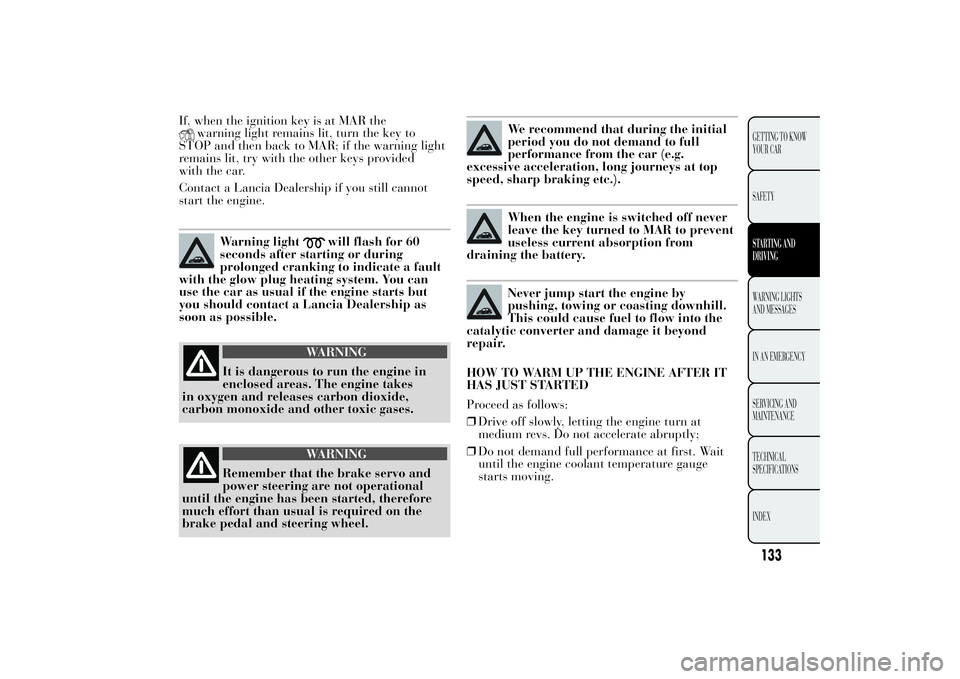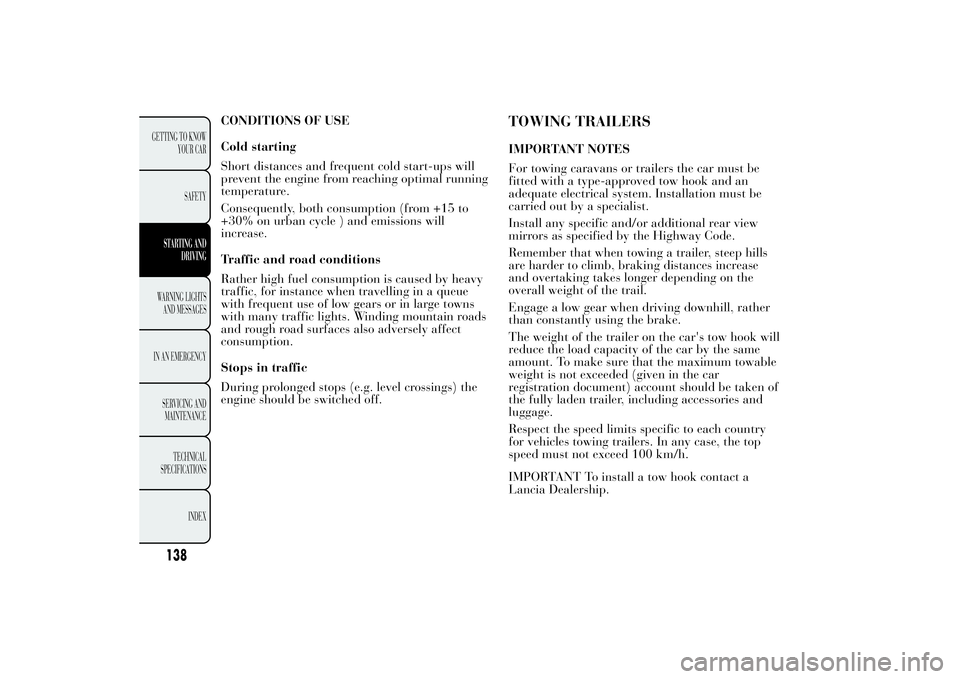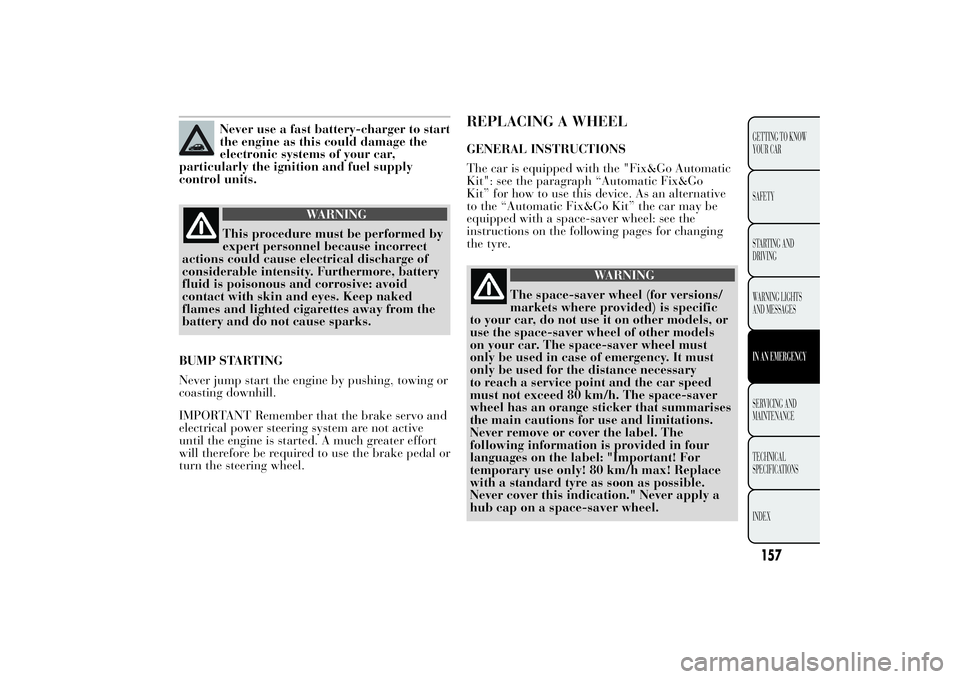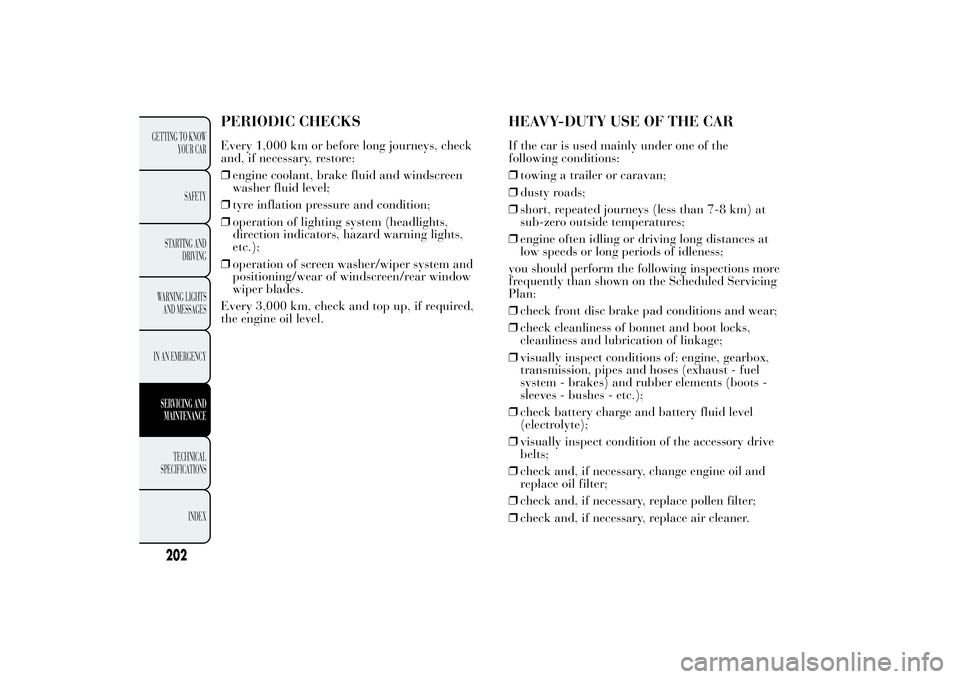towing Lancia Ypsilon 2011 Owner handbook (in English)
[x] Cancel search | Manufacturer: LANCIA, Model Year: 2011, Model line: Ypsilon, Model: Lancia Ypsilon 2011Pages: 299, PDF Size: 13.35 MB
Page 135 of 299

If, when the ignition key is at MAR the
warning light remains lit, turn the key to
STOP and then back to MAR; if the warning light
remains lit, try with the other keys provided
with the car.
Contact a Lancia Dealership if you still cannot
start the engine.
Warning light
will flash for 60
seconds after starting or during
prolonged cranking to indicate a fault
with the glow plug heating system. You can
use the car as usual if the engine starts but
you should contact a Lancia Dealership as
soon as possible.
WARNING
It is dangerous to run the engine in
enclosed areas. The
engine takes
in oxygen and releases carbon dioxide,
carbon monoxide and other toxic gases.
WARNING
Remember that the brake servo and
power steering are
not operational
until the engine has been started, therefore
much effort than usual is required on the
brake pedal and steering wheel.
We recommend that during the initial
period you do not demand to full
performance from the car (e.g.
excessive acceleration, long journeys at top
speed, sharp braking etc.).When the engine is switched off never
leave the key turned to MAR to prevent
useless current absorption from
draining the battery.Never jump start the engine by
pushing, towing or coasting downhill.
This could cause fuel to flow into the
catalytic converter and damage it beyond
repair.
HOW TO WARM UP THE ENGINE AFTER IT
HAS JUST STARTED
Proceed as follows:
❒Drive off slowly, letting the engine turn at
medium revs. Do not accelerate abruptly;
❒Do not demand full performance at first. Wait
until the engine coolant temperature gauge
starts moving.
133GETTING TO KNOW
YOUR CAR
SAFETYSTARTING AND
DRIVINGWARNING LIGHTS
AND
MESSAGES
IN AN
EMERGENCY
SERVICING AND
MAINTENANCE
TECHNICAL
SPECIFICATIONS
INDEX
Page 140 of 299

CONDITIONS OF USE
Cold starting
Short distances and frequent cold start-ups will
prevent the engine from reaching optimal running
temperature.
Consequently, both consumption (from +15 to
+30% on urban cycle ) and emissions will
increase.
Traffic and road conditions
Rather high fuel consumption is caused by heavy
traffic, for instance when travelling in a queue
with frequent use of low gears or in large towns
with many traffic lights. Winding mountain roads
and rough road surfaces also adversely affect
consumption.
Stops in traffic
During prolonged stops (e.g. level crossings) the
engine should be switched off.
TOWING TRAILERSIMPORTANT NOTES
For towing caravans or trailers the car must be
fitted with a type-approved tow hook and an
adequate electrical system. Installation must be
carried out by a specialist.
Install any specific and/or additional rear view
mirrors as specified by the Highway Code.
Remember that when towing a trailer, steep hills
are harder to climb, braking distances increase
and overtaking takes longer depending on the
overall weight of the trail.
Engage a low gear when driving downhill, rather
than constantly using the brake.
The weight of the trailer on the car's tow hook will
reduce the load capacity of the car by the same
amount. To make sure that the maximum towable
weight is not exceeded (given in the car
registration document) account should be taken of
the fully laden trailer, including accessories and
luggage.
Respect the speed limits specific to each country
for vehicles towing trailers. In any case, the top
speed must not exceed 100 km/h.
IMPORTANT To install a tow hook contact a
Lancia Dealership.
138
GETTING TO KNOW
YOUR CAR
SAFETY
STARTING AND
DRIVINGWARNING LIGHTS
AND
MESSAGES
IN AN
EMERGENCY
SERVICING AND
MAINTENANCE
TECHNICAL
SPECIFICATIONS
INDEX
Page 149 of 299

HOT ENGINE COOLANT
(red)
Turning the key to the MAR-ON position
illuminates the warning light, but it should switch
off after a few seconds. The warning light switches
on (on some versions, with a message on the
display and a symbol on the display) when the
engine is overheated.
If the warning light comes on when driving,
proceed as follows:
❒when driving normally:stop the car, switch
off the engine and check that the water level
in the reservoir is not below the MIN mark. If it
is, wait for a few minutes for the engine to
cool down then slowly and carefully open the
cap, top up with coolant and check that the
level is between the MIN and MAX marks. Also
check visually for any fluid leaks. Go to a
Lancia Dealership if the warning light should
switch on when the engine is started again;
❒if the vehicle is used under demanding
conditions(e.g. towing trailers uphill or fully
loaded): slow down and, if the light stays on,
stop the car. Wait for 2 or 3 minutes with the
engine running and slightly accelerated to
further favour the coolant circulation. Then stop
the engine. Check the correct liquid level as
described above.
IMPORTANT Over demanding routes, it is
advisable to keep the engine on and slightly
accelerated for a few minutes before switching it
off.
FUEL RESERVE – LIMITED
RANGE (amber)
This warning light comes on when about 5 to 7
litres of fuel are left in the tank. When the
remaining range is approx. 50 km (or equivalent
value in miles), on some versions, the display
will show a warning message.
IMPORTANT The warning light will flash to
indicate a system failure. Go to a Lancia
Dealership to have the system checked.
EOBD/INJECTION SYSTEM
FAILURE (amber)
In normal conditions, the warning light switches
on when the key is turned to MAR (on some
versions, with a message on the display), but
should switch off as soon as the engine is started.
147GETTING TO KNOW
YOUR CAR
SAFETY
STARTING AND
DRIVINGWARNING LIGHTS
AND
MESSAGESIN AN
EMERGENCY
SERVICING AND
MAINTENANCE
TECHNICAL
SPECIFICA
TIONS
INDEX
Page 159 of 299

Never use a fast battery-charger to start
the engine as this could damage the
electronic systems of your car,
particularly the ignition and fuel supply
control units.
WARNING
This procedure must be performed by
expert personnel because
incorrect
actions could cause electrical discharge of
considerable intensity. Furthermore, battery
fluid is poisonous and corrosive: avoid
contact with skin and eyes. Keep naked
flames and lighted cigarettes away from the
battery and do not cause sparks.
BUMP STARTING
Never jump start the engine by pushing, towing or
coasting downhill.
IMPORTANT Remember that the brake servo and
electrical power steering system are not active
until the engine is started. A much greater effort
will therefore be required to use the brake pedal or
turn the steering wheel.
REPLACING A WHEELGENERAL INSTRUCTIONS
The car is equipped with the "Fix&Go Automatic
Kit": see the paragraph “Automatic Fix&Go
Kit” for how to use this device. As an alternative
to the “Automatic Fix&Go Kit” the car may be
equipped with a space-saver wheel: see the
instructions on the following pages for changing
the tyre.
WARNING
The space-saver wheel (for versions/
markets where provided)
is specific
to your car, do not use it on other models, or
use the space-saver wheel of other models
on your car. The space-saver wheel must
only be used in case of emergency. It must
only be used for the distance necessary
to reach a service point and the car speed
must not exceed 80 km/h. The space-saver
wheel has an orange sticker that summarises
the main cautions for use and limitations.
Never remove or cover the label. The
following information is provided in four
languages on the label: "Important! For
temporary use only! 80 km/h max! Replace
with a standard tyre as soon as possible.
Never cover this indication." Never apply a
hub cap on a space-saver wheel.
157GETTING TO KNOW
YOUR CAR
SAFETY
STARTING AND
DRIVING
WARNING LIGHTS
AND MESSAGESIN AN EMERGENCYSERVICING AND
MAINTENANCE
TECHNICAL
SPECIFICA
TIONS
INDEX
Page 196 of 299

RAISING THE CARIf the car needs to be raised, go to a Lancia
Dealership, which will be equipped with arm
hoists or workshop lifts.
TOWING THE CARThe tow hook, which is supplied with the car, is
housed in the tool box, under the carpet in the
luggage compartment.
ATTACHING THE TOW HOOK
Manually remove cap A fig. 156 (front bumper) or
A fig. 157 (rear bumper) pressing the lower part,
take the tow hook B fig. 156 (front bumper) or
B fig. 157 (rear bumper) from its housing in
the tool box and tighten it completely on the front
or rear threaded pin.
fig. 156
L0F0021
194
GETTING TO KNOW
YOUR CAR
SAFETY
STARTING AND
DRIVING
WARNING LIGHTS
AND MESSAGESIN AN EMERGENCYSERVICING AND
MAINTENANCE
TECHNICAL
SPECIFICA
TIONS
INDEX
Page 197 of 299

WARNING
Before towing, turn the ignition key to
MAR and then
to STOP without
removing it. The steering column will
automatically lock when the key is removed
and the wheels cannot be steered.
WARNING
Before tightening the hook clean the
threaded housing thoroughly
. Make
sure that the hook is fully fastened in the
housing before towing the car.
WARNING
Whilst towing, remember that as the
assistance of the
brake servo and
the electric power assisted steering is not
available, greater force needs to be exerted
on the brake pedal and more effort is
required on the steering wheel. Do not use
flexible cables when towing and avoid jerky
movements. During towing, make sure that
the trailer hitch does not damage any
components it is touching. When towing the
car, it is compulsory to respect specific
highway code regulations relating to the tow
hook and procedures for towing on the
road. Do not start the engine while towing
the car.
fig. 157
L0F0022
195GETTING TO KNOW
YOUR CAR
SAFETY
STARTING AND
DRIVING
WARNING LIGHTS
AND MESSAGESIN AN EMERGENCYSERVICING AND
MAINTENANCE
TECHNICAL
SPECIFICA
TIONS
INDEX
Page 198 of 299

WARNING
The front and rear tow hooks should
be used only
for emergencies on
the road. You are allowed to tow the car for
short distances using an appropriate device
in accordance with the highway code (a rigid
bar), to move the vehicle on the road in
readiness for towing or transporting via a
breakdown vehicle. Tow hooks MUST NOT
be used to tow vehicles off the road or where
there are obstacles and/or for towing
operations using cables or other non-rigid
devices. Respecting the above conditions,
towing must take place with the two vehicles
(one towing, the other towed) aligned as
much as possible along the same centre line.
196
GETTING TO KNOW
YOUR CAR
SAFETY
STARTING AND
DRIVING
WARNING LIGHTS
AND MESSAGESIN AN EMERGENCYSERVICING AND
MAINTENANCE
TECHNICAL
SPECIFICA
TIONS
INDEX
Page 199 of 299

SERVICING AND MAINTENANCE
SCHEDULED SERVICINGCorrect servicing is essential in guaranteeing a
long life for the car under the best conditions.
Lancia has prepared a series of checks and service
operations to be carried out every 30,000
kilometres (for petrol versions) or every 35,000
kilometres (for diesel versions).
Check the items on the Scheduled Servicing Plan
(e.g. periodically check level of liquids, tyre
pressure, etc.) before 30,000/35,000 km and
between these services deadlines.
Scheduled Services are offered by all Lancia
Dealerships according to a set time schedule. If,
during each operation, in addition to the ones
scheduled, the need arises for further
replacements or repairs, these may be carried out
only with the explicit agreement of the Customer.
If your car is used frequently for towing, the
interval between one service operation and the
next should be reduced.WARNING
At 2000 km from the next service operation the
display will show a message.
The Scheduled Services are set out by the
Manufacturer. Failure to have them carried out
may invalidate the warranty.
It is advisable to inform the Lancia Dealership of
any small operating irregularities without waiting
for the next service.
197GETTING TO KNOW
YOUR CAR
SAFETY
STARTING AND
DRIVING
WARNING LIGHTS
AND MESSAGES
IN AN EMERGENCYSERVICING AND
MAINTENANCETECHNICAL
SPECIFICA
TIONS
INDEX
Page 204 of 299

PERIODIC CHECKSEvery 1,000 km or before long journeys, check
and, if necessary, restore:
❒engine coolant, brake fluid and windscreen
washer fluid level;
❒tyre inflation pressure and condition;
❒operation of lighting system (headlights,
direction indicators, hazard warning lights,
etc.);
❒operation of screen washer/wiper system and
positioning/wear of windscreen/rear window
wiper blades.
Every 3,000 km, check and top up, if required,
the engine oil level.
HEAVY-DUTY USE OF THE CARIf the car is used mainly under one of the
following conditions:
❒towing a trailer or caravan;
❒dusty roads;
❒short, repeated journeys (less than 7-8 km) at
sub-zero outside temperatures;
❒engine often idling or driving long distances at
low speeds or long periods of idleness;
you should perform the following inspections more
frequently than shown on the Scheduled Servicing
Plan:
❒check front disc brake pad conditions and wear;
❒check cleanliness of bonnet and boot locks,
cleanliness and lubrication of linkage;
❒visually inspect conditions of: engine, gearbox,
transmission, pipes and hoses (exhaust - fuel
system - brakes) and rubber elements (boots -
sleeves - bushes - etc.);
❒check battery charge and battery fluid level
(electrolyte);
❒visually inspect condition of the accessory drive
belts;
❒check and, if necessary, change engine oil and
replace oil filter;
❒check and, if necessary, replace pollen filter;
❒check and, if necessary, replace air cleaner.
202
GETTING TO KNOW
YOUR CAR
SAFETY
STARTING AND
DRIVING
WARNING LIGHTS
AND MESSAGES
IN AN EMERGENCYSERVICING AND
MAINTENANCE
TECHNICAL
SPECIFICA
TIONS
INDEX
Page 297 of 299

Setup for "Isofix" child
seat ................................... 122
Side air diffusers .................. 35
Side Bag ............................. 127
Side lights/brake lights ....... 176
Side lights/day lights
(DRL)
– bulb replacement............ 172
Snow chains........................ 140
Sound system (wiring) ......... 90
Spark plugs (type) .............. 223
Speedometer ........................ 8
Speedometer (speed
indicator) ........................... 7
Starting the engine ...... 132-156
Starting up and driving....... 132
Start&Stop system ............... 83
Start&Stop (system)............. 83
Steering .............................. 226
Steering lock ........................ 28
Steering Wheel ..................... 32
Steering wheel stalks
– left stalk .......................... 47
Storing the car .................... 141
Sun roof ............................... 64
Sun visors ............................ 62Suspension.......................... 226
Technical data.................... 220
Third brake light ................ 176
Top speed ........................... 234
Towing the car .................... 194
Towing trailers .................... 138
Transmission ...................... 224
TRIP button ......................... 21
Trip Computer
– TRIP button .................... 21
– Trip Computer ................. 19
– Trip Computer
parameters ...................... 20
Ty r e s
– correct tyre reading ........ 227
– Fix&Go Automatic (kit) . 163
– inflation pressures .......... 231
– Rim Protector tyres ........ 232
– snow tyres ...................... 228
– tyres provided ................ 228
Tyres - maintenance............ 211"Universal" child seat
fitting................................ 124
Universal Isofix (child
seat).................................. 122
Using the gearbox ............... 135W
arning lights on panel ..... 142
Weights and loads ............... 235
Welcome movement ............. 11
Wheel rims
– correct reading of the
wheel rim ....................... 228
– dimensions ..................... 228
– rim protector .................. 232
– rims and tyres ................ 227
– wheels and tyres ............. 211
Wheels and tyres
– changing a wheel ............ 157
– Fix&Go Automatic (kit) . 163
– spare wheel .................... 227
– tyre inflation pressure..... 231
– Wheels and tyres ............ 211
Window bag........................ 128
Window cleaning .................. 50
Windows (cleaning) ............ 217
295GETTING TO
KNOW YOUR CAR
SAFETY
STARTING AND
DRIVING
WARNING LIGHTS
AND MESSAGES
IN AN EMERGENCY
SERVICING AND
MAINTENANCE
TECHNICAL
SPECIFICATIONSINDEX